
Justicia brandegeeana, the Mexican shrimp plant, shrimp plant or false hop, is an evergreen shrub in the genus Justicia of the acanthus family Acanthaceae, native to Mexico, and also naturalized in Florida.

Gesneriaceae, the gesneriad family, is a family of flowering plants consisting of about 152 genera and ca. 3,540 species in the tropics and subtropics of the Old World and the New World, with a very small number extending to temperate areas. Many species have colorful and showy flowers and are cultivated as ornamental plants.
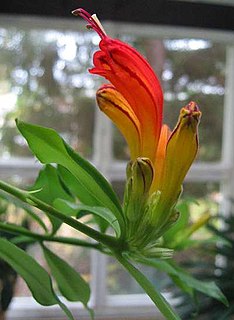
Aeschynanthus is a genus of about 150 species of evergreen subtropical and tropical plants in the family Gesneriaceae. They are usually trailing epiphytes with brightly colored flowers that are pollinated by sunbirds. The genus name comes from a contraction of aischuno and anthos (flower). The common name for some species is "lipstick plant", which comes from the appearance of the developing buds. A full list of the accepted species and their synonyms can be found in the Smithsonian Institution's World Checklist of Gesneriaceae.
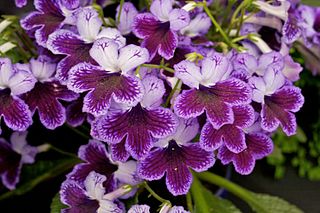
A popular house plant, Streptocarpus, is an Afrotropical genus of flowering plants in the family Gesneriaceae. The genus is native to Afromontane biotopes from central, eastern and southern Africa, including Madagascar and the Comoro Islands. The flowers are five-petalled, salverform tubes, almost orchid-like in appearance, and hover or arch over the plant, while the pointed, elongate fruit is of a helical form similar to that of the "tusk" of a narwhal. In the wild, species can be found growing on shaded rocky hillsides or cliffs, on the ground, in rock crevices, and almost anywhere the seed can germinate and grow. For the home, there are now many hybrids of various colours and forms available.

Agave victoriae-reginae, the Queen Victoria agave or royal agave, is a small species of succulent flowering perennial plant, noted for its streaks of white on sculptured geometrical leaves, and popular as an ornamental.

Primula elatior, the oxlip, is a species of flowering plant in the family Primulaceae, native to nutrient-poor and calcium-rich damp woods and meadows throughout Europe, with northern borders in Denmark and southern parts of Sweden, eastwards to the Altai Mountains and on the Kola Peninsula in Russia, and westwards in the British Isles.
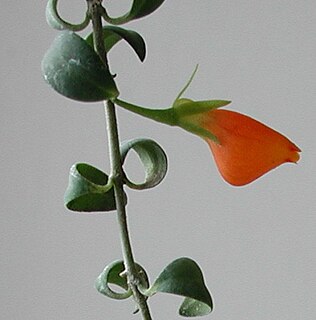
Nematanthus is a genus of flowering plants in the family Gesneriaceae. All of its species are endemic to Brazil. Compared to other gesneriads, Nematanthus has leaves that are small, succulent, and hard-surfaced. The plant has a trailing, branching, and spreading habit; it is generally an epiphyte in nature and a hanging-basket plant in cultivation. The flower has fused petals. In some species, the flower has a "pouch" at the bottom. The fancied resemblance of such flowers to a goldfish gives these plants the common name "goldfish plant" or "guppy plant".

Dracaena reflexa is a tree native to Mozambique, Madagascar, Mauritius, and other nearby islands of the Indian Ocean. It is widely grown as an ornamental plant and houseplant, valued for its richly coloured, evergreen leaves, and thick, irregular stems.

Sedum morganianum, the donkey tail or burro's tail, is a species of flowering plant in the family Crassulaceae, native to southern Mexico. It is a succulent perennial producing trailing stems up to 60 cm (24 in) long, with fleshy blue-green leaves and terminal pink to red flowers in summer. S. morganianum has been found wild in two ravines at Tenampa county, in central Veracruz, in eastern Mexico and on vertical cliffs of igneous rock in the Tropical Deciduous Forest zone. Due to its restricted geographic distribution, it should be regarded as a micro-endemic species.

Acalypha hispida, the chenille plant, is a flowering shrub which belongs to the family Euphorbiaceae, the subfamily Acalyphinae, and the genus Acalypha. Acalypha is the fourth largest genus of the family Euphorbiaceae, and contains many plants native to Hawaii and Oceania.

Acacia retinodes is an evergreen shrub that is native to South Australia, Victoria and Tasmania. Short racemes of yellow flowers are produced periodically throughout the year. Some common names are Retinodes water wattle, swamp wattle, wirilda, ever-blooming wattle and silver wattle.

Calathea zebrina, the zebra plant, is a species of plant in the family Marantaceae, native to southeastern Brazil. Under the synonym Goeppertia zebrina this plant has gained the Royal Horticultural Society's Award of Garden Merit.
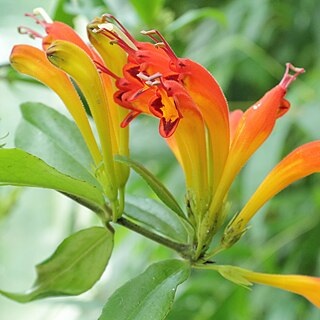
Aeschynanthus speciosus, also known as the basket plant, is a species of flowering plant in the family Gesneriaceae. There are many species of Aeschynanthus, all of which have long, trailing stems and bright flowers. The large, fleshy, dark green leaves are up to 10 cm (4 in) long and 4 cm wide and are arranged in groups along the stems. The flowers can be as long as 10 cm (4 in) and grow in clusters that usually consist of 6–20 flowers. Most of the time they are shaded in different colors, from orange–yellow in the lower area to orange–red at the tip with a blotched red inside and a yellow streaked throat.
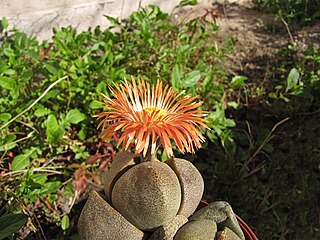
Pleiospilos nelii, the split rock, splitrock or living granite, is a species of flowering plant in the family Aizoaceae, native to South Africa. It grows in semi-arid areas with rainfall of between 150mm and 300mm, in the Karoo of South Africa.
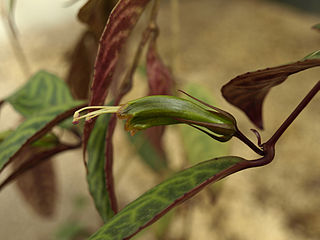
Aeschynanthus longicaulis is a species of perennial plant in the family Gesneriaceae, native to Vietnam, Thailand and Malaysia. Naturally, it grows as an epiphyte on trees. The leaves are pointed, 6-12 cm long and 2-3 cm wide, and are dark green marbled with a creamy white on the top and pale green marbled with maroon on the underside. It produces clusters of tubular orange flowers up to 5 cm long on trailing purple stems, from summer to winter. The flowers give way to 30cm-long capsules containing multiple seeds.

Aloe bakeri is a species of flowering plant in the family Asphodelaceae, native to Madagascar, where it grows on rocky hills at low elevations. Growing to 10–20 cm (4–8 in) tall by 40 cm (16 in) wide, it is an evergreen perennial forming multiple rosettes of spidery succulent green or reddish-green toothed leaves, heavily mottled with white. The leaves are typically 10 cm long and bear straight or slightly curved white teeth that are 1 mm long and about 1-2 mm apart. In summer it produces red or orange, green-tipped tubular flowers. These flowers are attractive to birds, bees, and wasps, and are typically 2 cm long, borne on racemes 30 cm tall.

Maranta leuconeura, also known as prayer plant, is a species of flowering plant in the family Marantaceae, native to the Brazilian tropical forests. It is a variable, rhizomatous perennial, growing to 30 cm (12 in) tall and broad, with crowded clumps of evergreen, strikingly-marked oval leaves, each up to 12 cm (5 in) long.
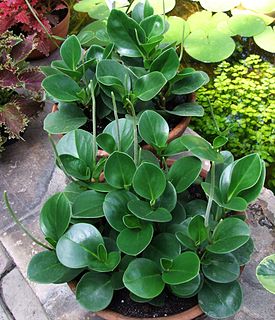
Peperomia obtusifolia, the baby rubberplant or pepper face, is a species of flowering plant in the family Piperaceae, native to Florida, Mexico and the Caribbean. The specific epithet obtusifolia means "blunt-leaved". The plant has gained the Royal Horticultural Society's Award of Garden Merit.
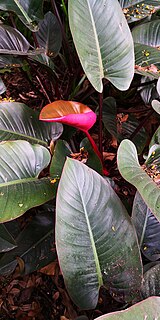
Philodendron erubescens, the blushing philodendron, is a species of flowering plant in the family Araceae, native to Colombia. It is a robust evergreen climber growing to 3–6 m (10–20 ft), with red stems and heart-shaped leaves up to 40 cm (16 in) in length. The flowers are deep red, fragrant spathes up to 15 cm (6 in) long, in summer and autumn.
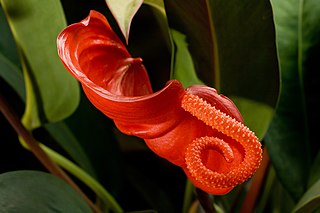
Anthurium scherzerianum, the flamingo flower or pigtail plant, is a species of Anthurium native to Costa Rica. It has gained the Royal Horticultural Society's Award of Garden Merit as an ornamental houseplant, kept at 15 °C (60 °F) or higher. It is naturally an epiphyte, growing on trees in the rainforest.























